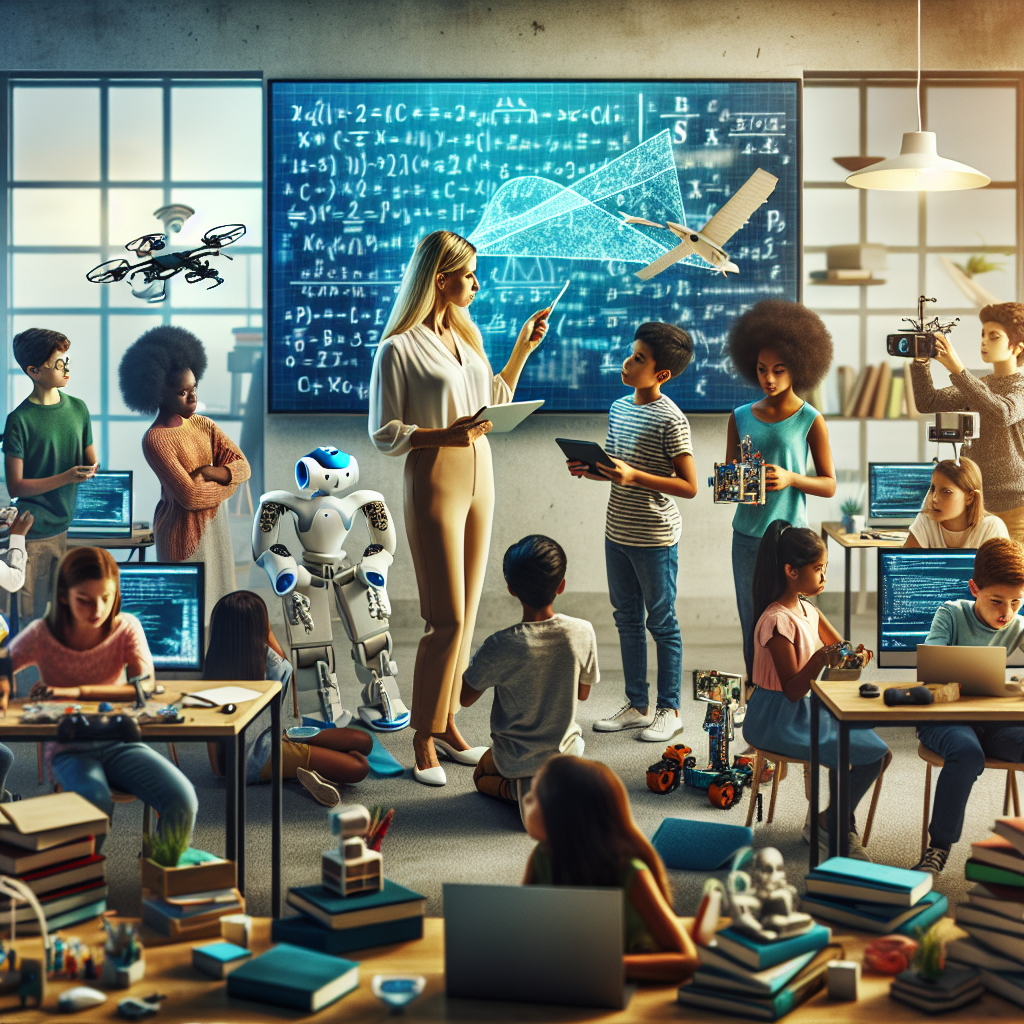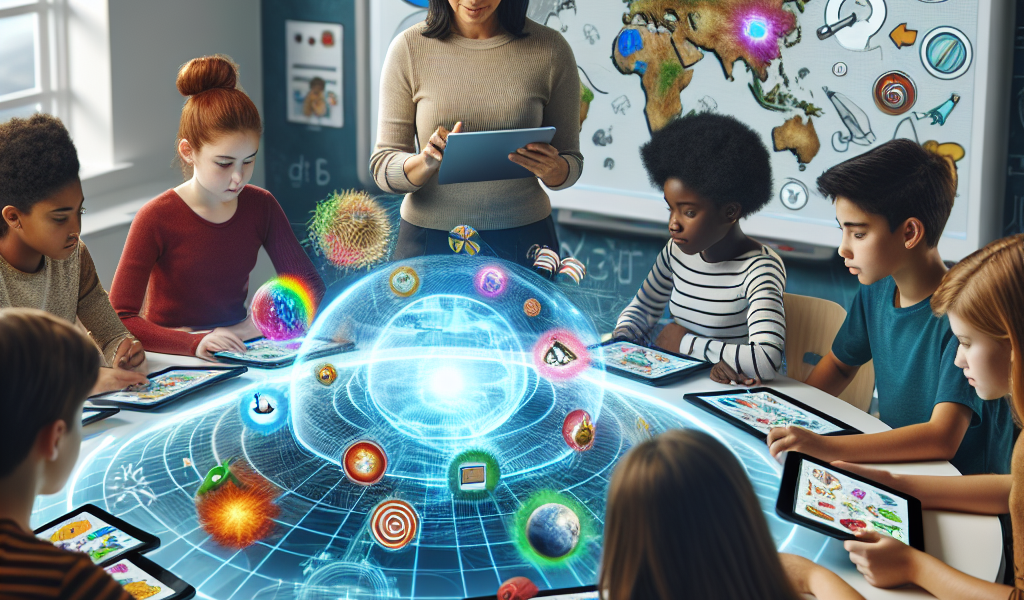-
Table of Contents
“Unlocking Potential: The Future of Education with Tech-Enhanced Learning”
Introduction

Exploring the Benefits of Tech-Enhanced Learning
In the rapidly evolving landscape of education, technology has emerged as a pivotal force, transforming traditional learning paradigms and offering unprecedented opportunities for both educators and students. Tech-enhanced learning, which integrates digital tools and resources into the educational process, has the potential to revolutionize the way knowledge is imparted and acquired. This approach not only facilitates personalized learning experiences but also fosters greater engagement, collaboration, and accessibility. By leveraging the power of technology, educational institutions can create dynamic and interactive learning environments that cater to diverse learning styles and needs, ultimately enhancing the overall educational experience and outcomes.
The Impact of Virtual Reality on Student Engagement
In recent years, the educational landscape has undergone a significant transformation, largely driven by the integration of advanced technologies. Among these innovations, virtual reality (VR) has emerged as a powerful tool with the potential to revolutionize student engagement. As educators and institutions strive to create more immersive and interactive learning experiences, the impact of VR on student engagement cannot be overstated.
To begin with, virtual reality offers an unparalleled level of immersion that traditional teaching methods simply cannot match. By transporting students into a three-dimensional, interactive environment, VR allows them to experience lessons in a more tangible and engaging way. For instance, instead of merely reading about ancient civilizations in a textbook, students can virtually explore the ruins of ancient Rome or walk through the streets of medieval Paris. This immersive experience not only makes learning more enjoyable but also helps students retain information more effectively.
Moreover, VR has the unique ability to cater to different learning styles. While some students thrive in a traditional classroom setting, others may struggle to stay engaged with conventional teaching methods. Virtual reality addresses this issue by providing a multi-sensory learning experience that can appeal to visual, auditory, and kinesthetic learners alike. By engaging multiple senses, VR helps to create a more inclusive learning environment where all students have the opportunity to succeed.
In addition to enhancing engagement, virtual reality also fosters collaboration and teamwork among students. Many VR applications are designed to be used in group settings, encouraging students to work together to solve problems and complete tasks. This collaborative approach not only helps to build essential social skills but also promotes a sense of community and shared purpose within the classroom. As students navigate virtual environments together, they learn to communicate effectively, delegate responsibilities, and support one another in achieving common goals.
Furthermore, virtual reality can help to bridge the gap between theoretical knowledge and real-world application. In subjects such as science and engineering, students often struggle to grasp complex concepts without hands-on experience. VR simulations provide a safe and controlled environment where students can experiment with different scenarios and observe the outcomes in real-time. For example, medical students can practice surgical procedures in a virtual operating room, while engineering students can test the structural integrity of their designs in a virtual wind tunnel. By allowing students to apply their knowledge in a practical context, VR helps to deepen their understanding and build confidence in their abilities.
Despite the numerous benefits of virtual reality in education, it is important to acknowledge the challenges and limitations associated with its implementation. High costs and technical difficulties can pose significant barriers for schools and institutions, particularly those with limited resources. Additionally, there is a learning curve associated with using VR technology, both for educators and students. To maximize the potential of VR in education, it is crucial for schools to invest in proper training and support for teachers, as well as to ensure that the technology is accessible to all students.
In conclusion, the impact of virtual reality on student engagement is profound and far-reaching. By providing immersive, multi-sensory learning experiences, fostering collaboration, and bridging the gap between theory and practice, VR has the potential to transform education for the better. As we continue to explore the benefits of tech-enhanced learning, it is essential to address the challenges and work towards creating an inclusive and equitable educational environment for all students.
How Artificial Intelligence is Personalizing Education
In recent years, the integration of artificial intelligence (AI) into educational systems has revolutionized the way students learn and teachers instruct. This technological advancement is not just a fleeting trend but a transformative force that is reshaping the educational landscape. By personalizing education, AI is addressing the diverse needs of students, making learning more engaging and effective.
One of the most significant benefits of AI in education is its ability to tailor learning experiences to individual students. Traditional classroom settings often struggle to accommodate the varying paces at which students learn. Some students grasp concepts quickly, while others may need more time and different approaches to understand the same material. AI-driven platforms can analyze a student’s performance in real-time, identifying strengths and weaknesses. This data allows the system to adjust the curriculum dynamically, providing additional resources or alternative explanations to ensure comprehension. Consequently, students receive a more customized education that caters to their unique learning styles and needs.
Moreover, AI is enhancing the role of teachers by alleviating some of their administrative burdens. Grading assignments, tracking student progress, and managing classroom activities can be time-consuming tasks that detract from the core mission of teaching. AI-powered tools can automate these processes, giving educators more time to focus on developing lesson plans, engaging with students, and fostering a supportive learning environment. This shift not only improves the quality of education but also helps prevent teacher burnout, a growing concern in the profession.
In addition to personalizing learning and supporting teachers, AI is also making education more accessible. For students with disabilities, AI technologies can provide tailored support that traditional methods may lack. For instance, speech recognition software can assist students with dyslexia by converting spoken words into text, while AI-driven apps can translate educational materials into braille for visually impaired students. These innovations ensure that all students, regardless of their physical or cognitive challenges, have the opportunity to succeed academically.
Furthermore, AI is fostering a more interactive and engaging learning experience. Gamified learning platforms, powered by AI, transform educational content into interactive games that motivate students to learn through play. These platforms can adapt to a student’s progress, offering increasingly challenging tasks as their skills improve. This approach not only makes learning fun but also encourages students to take an active role in their education, promoting a lifelong love of learning.
However, the integration of AI in education is not without its challenges. Concerns about data privacy and the ethical use of AI are paramount. Schools and educational institutions must ensure that the data collected from students is secure and used responsibly. Additionally, there is a need for ongoing research and dialogue to address potential biases in AI algorithms that could inadvertently disadvantage certain groups of students.
Despite these challenges, the potential benefits of AI in personalizing education are immense. By providing tailored learning experiences, supporting teachers, making education more accessible, and creating engaging learning environments, AI is poised to transform education for the better. As we continue to navigate this technological frontier, it is crucial to approach it with a balanced perspective, recognizing both its potential and its pitfalls. In doing so, we can harness the power of AI to create a more inclusive, effective, and enjoyable educational experience for all students.
The Role of Gamification in Modern Classrooms
In recent years, the integration of technology into education has revolutionized the way students learn and teachers instruct. One of the most compelling advancements in this domain is the use of gamification in modern classrooms. Gamification, the application of game-design elements in non-game contexts, has emerged as a powerful tool to enhance student engagement, motivation, and overall learning outcomes. This innovative approach is not merely a trend but a transformative shift that addresses some of the most pressing challenges in education today.
To begin with, gamification taps into the intrinsic motivation of students. Traditional teaching methods often struggle to maintain student interest, leading to disengagement and poor academic performance. By incorporating elements such as points, badges, leaderboards, and challenges, gamification creates a dynamic and interactive learning environment. These elements provide immediate feedback and a sense of accomplishment, which are crucial for sustaining student interest. For instance, a math app that rewards students with badges for solving problems can make the learning process more enjoyable and less intimidating.
Moreover, gamification fosters a sense of competition and collaboration among students. While competition can drive students to excel, collaboration encourages teamwork and the sharing of knowledge. In a gamified classroom, students might work together to complete quests or challenges, thereby developing essential social skills and a sense of community. This dual approach not only enhances academic performance but also prepares students for real-world scenarios where both competition and collaboration are key.
Another significant benefit of gamification is its ability to cater to diverse learning styles. Every student is unique, with different strengths, weaknesses, and preferences. Gamified learning platforms often offer a variety of activities and challenges that can be tailored to individual needs. For example, visual learners might benefit from interactive simulations, while kinesthetic learners might engage more with hands-on activities. This personalized approach ensures that no student is left behind, making education more inclusive and effective.
Furthermore, gamification can make complex subjects more accessible. Subjects like science, technology, engineering, and mathematics (STEM) often pose difficulties for many students. Gamified learning tools can simplify these subjects by breaking them down into manageable tasks and presenting them in a fun and engaging manner. A game-based science app, for instance, might allow students to conduct virtual experiments, making abstract concepts more concrete and understandable.
However, it is essential to recognize that gamification is not a panacea. While it offers numerous benefits, it must be implemented thoughtfully to avoid potential pitfalls. Overemphasis on rewards can lead to extrinsic motivation, where students are driven solely by the desire to earn points or badges rather than a genuine interest in learning. Therefore, educators must strike a balance, ensuring that gamification complements rather than overshadows the educational content.
In addition, the success of gamification largely depends on the quality of the games and the way they are integrated into the curriculum. Poorly designed games or those that do not align with educational objectives can be counterproductive. Hence, collaboration between educators, game designers, and educational psychologists is crucial to develop effective gamified learning experiences.
In conclusion, the role of gamification in modern classrooms is undeniably significant. By enhancing student engagement, fostering competition and collaboration, catering to diverse learning styles, and making complex subjects more accessible, gamification holds the potential to transform education. However, its implementation must be carefully managed to ensure that it serves as a valuable addition to traditional teaching methods. As we continue to explore the benefits of tech-enhanced learning, gamification stands out as a promising avenue to create more engaging, inclusive, and effective educational experiences.
Conclusion
Tech-enhanced learning offers numerous benefits, including increased accessibility, personalized learning experiences, and enhanced engagement through interactive and multimedia content. It supports diverse learning styles and paces, facilitates real-time feedback and assessment, and fosters collaboration through digital platforms. Additionally, it prepares students for a technology-driven world, equipping them with essential digital skills. Overall, tech-enhanced learning has the potential to significantly improve educational outcomes and create more inclusive and effective learning environments.





